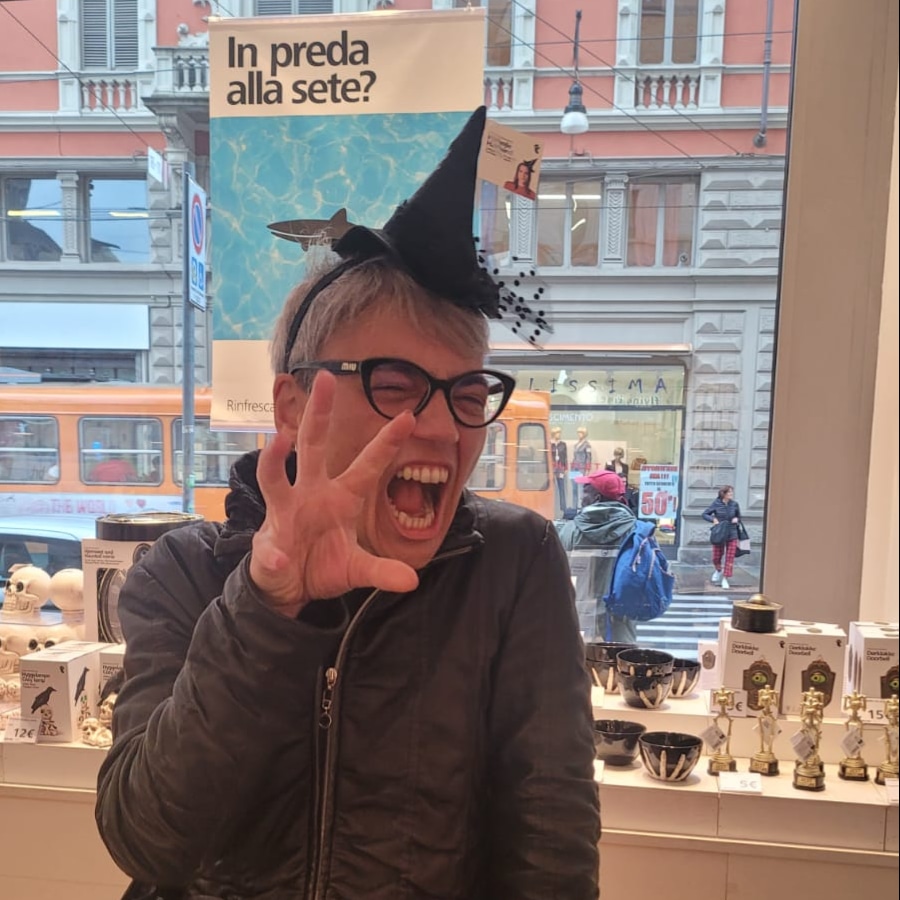POMPEI, 4-hour walking tour through time



[{"address":"Piazza Immacolata","location":{"longitudeDelta":0.10218818160659443,"latitudeDelta":0.09219986310369421,"latitude":40.7488587136828,"longitude":14.49535280000001},"media":[{"type":"img","content":"https://firebasestorage.googleapis.com/v0/b/freeguides-prod.appspot.com/o/assets%2Ftours%2F0kGaWU97mUIoYKURMICR%2Ffacebook_1670857161530_7008082876037275115.jpg?alt=media&token=b793e379-1d19-4bae-8024-15dbbd1b7350"},{"type":"text","content":"Welcome to Pompei! I’m Arianna and I’ll be your guide to enjoy an unforgettable experience discovering one of the most famous cities of the Ancient Rome era."},{"type":"img","content":"https://firebasestorage.googleapis.com/v0/b/freeguides-prod.appspot.com/o/assets%2Ftours%2F0kGaWU97mUIoYKURMICR%2Fintro.jpg?alt=media&token=9d7992bd-7114-43eb-9f13-9c0d2a23f0bb"},{"type":"text","content":"**Before you start, here're some tips for you:**\n- wear comfortable shoes and possibly closed because the flooring inside the site is not regular.\n- if you visit Pompeii in summer, bring some water with you. There is a kiosk inside the site but it is always stormed and you have to anticipate long queues.\n- if you intend to visit it in winter, know that there are few places where you can shelter so bring a raincoat and a small umbrella.\n- it is forbidden to enter with backpacks, umbrellas, suitcases and bulky bags. There is free luggage storage at the entrance.\n\nAt the entrance of the site, you will probably be *assaulted* by guides but know that you can visit the site of Pompeii with absolute autonomy. With this tour, you will discover the highlights, in a route that I planned to be 4 hours to give all the time to admire these wonders calmly.\n\nYou can buy the ticket here:\n"},{"type":"link","content":"www.ticketone.it/en/artist/scavi-pompei/parco-archeologico-di-pompei-988882/"}]},{"address":"Palestra Grande","location":{"longitudeDelta":0.10218818160659443,"latitudeDelta":0.09219986310369421,"latitude":40.75110198452944,"longitude":14.49487000237733},"media":[{"type":"img","content":"https://firebasestorage.googleapis.com/v0/b/freeguides-prod.appspot.com/o/assets%2Ftours%2F0kGaWU97mUIoYKURMICR%2Fanfiteatro%203.jpg?alt=media&token=f01ce6cf-81dd-4617-9596-4244359199a1"},{"type":"text","content":"Believing that this city petrified by the lava of Mount Vesuvius in 79 AD was almost two thousand years ago a place full of life in the middle of the Roman Empire can be difficult. But as soon as you enter you will realize the immensity of the archaeological site until the mid-eighteenth century completely petrified. \n\nThanks to the good preservation of its remains and the hard work of historians and archaeologists over the centuries, walking through the site you will be able to imagine what the social life and customs of the citizens of Pompeii were like. \n\nDiscover more below!\n\n"},{"type":"link","content":"www.dailywire.com/news/discoveries-at-pompeii-give-new-details-about-life-in-city-before-famed-volcanic-eruption"},{"type":"img","content":"https://firebasestorage.googleapis.com/v0/b/freeguides-prod.appspot.com/o/assets%2Ftours%2F0kGaWU97mUIoYKURMICR%2FPompei-Vesuvio-eruzione-79-dC.jpg?alt=media&token=57b53bed-97f3-440d-b14e-37558b686ac3"},{"type":"text","content":"First of all a brief historical note. Pompeii was founded around the eighth century BC and soon became an important commercial centre thanks to its strategic position overlooking the port of Naples.\nIn the third century BC it was conquered by the Romans and had a strong architectural development: in this period for example were built the rectangular Forum and the triangular Forum. \n\nPompeii soon became the \"holiday residence\" of the Roman patriciate and, in the imperial age, many families moved here and had further buildings and temples built. But on August 24, 79 AD (according to some sources on October 24 of the same year) the eruption of Vesuvius destroyed Pompeii, freezing it to this day and killing about 1600 people.\n"},{"type":"img","content":"https://firebasestorage.googleapis.com/v0/b/freeguides-prod.appspot.com/o/assets%2Ftours%2F0kGaWU97mUIoYKURMICR%2Fmappa%20scavi.jpg?alt=media&token=39cecff3-0e19-4d26-b3d9-2ffa1b9fe0a8"},{"type":"text","content":"Completely covered by a few meters of magmatic material, Pompeii, over the years was invaded by vegetation. The rediscovery of Pompeii took place in 1748 at the behest of Charles III of Bourbon. And since then about 50 hectares have been brought to light against the total 63 of the city. \nAmong the remains of Pompeii that have come down to us, visit the Amphitheater as a first stop. \n"},{"type":"img","content":"https://firebasestorage.googleapis.com/v0/b/freeguides-prod.appspot.com/o/assets%2Ftours%2F0kGaWU97mUIoYKURMICR%2Fanfiteatro.jpg?alt=media&token=a859680e-7732-4d65-9cae-318c7f901562"},{"type":"text","content":"The Roman amphitheater of Pompeii is the oldest survivor in the world! Even the Colosseum in Rome was built almost a century later! \nIt was built around 70 BC, in the southeast of the ancient city and was brought to light in 1748. \nAn important part of the city's leisure time took place here, with shows, games and, of course, battles. \n"},{"type":"img","content":"https://firebasestorage.googleapis.com/v0/b/freeguides-prod.appspot.com/o/assets%2Ftours%2F0kGaWU97mUIoYKURMICR%2Fanfiteatro2.jpg?alt=media&token=8dda4805-3a5c-434b-93f6-f69c053baa26"},{"type":"text","content":"At first glance, it is not as large or impressive as the Colosseum in Rome, the stands are smaller and there is only grass and sand. \nBut imagine in the HORA SEPTIMA, the moment of the day of fun, twenty thousand spectators participate in a gladiator show offered by some rich Pompeian eager to make a political career. It must have been an incredible show!\n"}]},{"address":"Foro di Pompei","location":{"longitudeDelta":0.10218818160659443,"latitudeDelta":0.09219986310369421,"latitude":40.749288613682985,"longitude":14.484728199999983},"media":[{"type":"img","content":"https://firebasestorage.googleapis.com/v0/b/freeguides-prod.appspot.com/o/assets%2Ftours%2F0kGaWU97mUIoYKURMICR%2Fforo1.jpg?alt=media&token=511589ef-2195-4413-ba73-8fb2be7b4efe"},{"type":"text","content":"The Forum of Pompeii was the main structure of the city and represented its political, economic and religious center. It was built in the fourth century by the Samnites and later expanded and renovated by the Romans, who added numerous buildings around the perimeter. \nIn the Augustan era, the portico was built, the flooring was redone, a temple was erected in honour of Augustus and the Macellum was restored, used as a city market but also for banquets in honour of the emperor.\n"},{"type":"img","content":"https://firebasestorage.googleapis.com/v0/b/freeguides-prod.appspot.com/o/assets%2Ftours%2F0kGaWU97mUIoYKURMICR%2Fvita%20romani.jpg?alt=media&token=b5f135ae-8286-4603-a9f5-c40d95791a5e"},{"type":"text","content":"Now imagine in the HORA QUARTA the market in full swing, the peddlers declaiming praises to their goods while the buyers bargained over the price. In the forum in full swing, trials were also held and public affairs were discussed."},{"type":"img","content":"https://firebasestorage.googleapis.com/v0/b/freeguides-prod.appspot.com/o/assets%2Ftours%2F0kGaWU97mUIoYKURMICR%2Fforo3.jfif?alt=media&token=50cc310a-1d5b-415c-9e26-d4c2a2312068"},{"type":"text","content":"Two curiosities: the whole area was forbidden from the circulation of wagons, as a \"limited traffic area\" considering the fact that the buildings of the square were very frequented by people and it would have been dangerous to pass the wagons.\nIn the first century AD the monumental bases on the south side, in front of the urban administrative buildings, were decorated with honorary statues, while along the arcades were placed those of illustrious citizens.\nThe sculptures, however, were not found perhaps because they were removed by the Pompeians who returned after the eruption to take all the material considered recoverable.\n"}]},{"address":"Santuario di Apollo","location":{"longitudeDelta":0.10218818160659443,"latitudeDelta":0.09219986310369421,"latitude":40.74839336894889,"longitude":14.483879300000009},"media":[{"type":"img","content":"https://firebasestorage.googleapis.com/v0/b/freeguides-prod.appspot.com/o/assets%2Ftours%2F0kGaWU97mUIoYKURMICR%2Fil-tempio-di-apollo.jpg?alt=media&token=e9d46776-de03-401c-8bb3-6fcd3b73e67c"},{"type":"text","content":"The Temple of Apollo is the oldest and most important religious building in Pompeii. It was built between the eighth and seventh centuries BC and thanks to some artefacts found during excavations it is thought that it was initially designed as an outdoor space with altars. Only in the sixth century, BC appeared the first temple with a canopy decorated with terracotta. \nAt that time Apollo was the most worshipped deity of Pompeii and the Temple of Apollo was the most frequented place of worship in the city. \n"},{"type":"img","content":"https://firebasestorage.googleapis.com/v0/b/freeguides-prod.appspot.com/o/assets%2Ftours%2F0kGaWU97mUIoYKURMICR%2FPompeii_Regio_07_Insula_07_Temple_of_Apollo_plan_01.jpg?alt=media&token=e9ad3eac-b941-4b66-965a-ae04e1ece9a2"},{"type":"img","content":"https://firebasestorage.googleapis.com/v0/b/freeguides-prod.appspot.com/o/assets%2Ftours%2F0kGaWU97mUIoYKURMICR%2Fapollo2.jpg?alt=media&token=5d140b8e-0997-4738-8f7b-f3de7290a61d"},{"type":"text","content":"Following the beginning of a new cult, that of Jupiter, the Temple of Apollo lost importance and size. A wall was even built to avoid the view of the building from the surrounding houses and the plan was reduced to enlarge instead of that of the Forum. But during the Augustan era, during which the sundial was added, it returned to its former glory becoming a place of games in honour of Apollo: the Ludi Apollinari. \n\nDestroyed by the earthquake of 62 AD, which anticipated the fateful eruption of a few years later, it was still being rebuilt - and therefore not in use - when the eruption of 79 AD occurred.\n"},{"type":"img","content":"https://firebasestorage.googleapis.com/v0/b/freeguides-prod.appspot.com/o/assets%2Ftours%2F0kGaWU97mUIoYKURMICR%2FPompeii_-_Temple_of_Apollo-1920x1440.jpg?alt=media&token=28566500-d0b6-4064-a182-60f3b00c1aba"}]},{"address":"Terme Stabiane","location":{"longitudeDelta":0.10218818160659443,"latitudeDelta":0.09219986310369421,"latitude":40.74987264611084,"longitude":14.487419815899667},"media":[{"type":"img","content":"https://firebasestorage.googleapis.com/v0/b/freeguides-prod.appspot.com/o/assets%2Ftours%2F0kGaWU97mUIoYKURMICR%2Fterme_colonne.jpg?alt=media&token=55caf665-d22d-4366-b8fe-a5e35fc855d1"},{"type":"text","content":"The baths (or public baths) had a fundamental role in the daily life of the inhabitants of Pompeii, so much so that in the city there were several, although the best preserved are the Sabian Baths.\nWith very few exceptions, the water did not flow into the houses, so the Romans used the baths to wash. They were so basic that they had an affordable cost even for slaves. \nIn the HORA OCTAVA, it was therefore a well-established habit for any social rank to go to the spa, where business was also concluded and gymnastics could be done.\n"},{"type":"img","content":"https://firebasestorage.googleapis.com/v0/b/freeguides-prod.appspot.com/o/assets%2Ftours%2F0kGaWU97mUIoYKURMICR%2Fterme_interni.jpg?alt=media&token=2aac0184-e7bd-4c47-86e5-c115ff56d491"},{"type":"text","content":"The Terme Stabiane take its name from the Via Stabiana that runs next to it and was discovered in the early nineteenth century and then excavated between 1853 and 1858.\nThey are the oldest in all of Pompeii, as the oldest nucleus dates back to the fourth century BC, and was originally made up of the porticoed gym located in the courtyard, cells with single bathrooms and a quadrangular well, the oldest well in the city, with a water wheel operated by hand by a slave. \n\n"},{"type":"img","content":"https://firebasestorage.googleapis.com/v0/b/freeguides-prod.appspot.com/o/assets%2Ftours%2F0kGaWU97mUIoYKURMICR%2Fterme-stabiane6.jpg?alt=media&token=df71bddb-e53d-421a-8adb-d91219528c59"},{"type":"text","content":"The baths as you see them today, are not actually the original ones, as they were buried by the eruption and rebuilt in the second century AD.\nUpon entering you will find a large courtyard, to the left of which is the swimming pool, while to the right a porch that gives access to the male part divided into apodyterium (changing room), frigidarium (for cold baths), tepidarium (for medium temperature baths) and finally calidarium (for hot baths). "},{"type":"img","content":"https://firebasestorage.googleapis.com/v0/b/freeguides-prod.appspot.com/o/assets%2Ftours%2F0kGaWU97mUIoYKURMICR%2Fpozzo%20terme.jpg?alt=media&token=bff47005-2607-43c2-8cb5-6c112f2d0bf6"},{"type":"text","content":"Heating was ensured by a system of pipes in the walls and double floors that circulated the hot air coming from the furnaces and mobile braziers.\nThe female part, close to the male one, was similarly articulated in apodyterium, tepidarium and calidarium, but the whole was smaller and devoid of the rich decorations that characterize the male part. \n"}]},{"address":"Lupanare di Pompei","location":{"longitudeDelta":0.10218818160659443,"latitudeDelta":0.09219986310369421,"latitude":40.75028161368347,"longitude":14.486804700000011},"media":[{"type":"img","content":"https://firebasestorage.googleapis.com/v0/b/freeguides-prod.appspot.com/o/assets%2Ftours%2F0kGaWU97mUIoYKURMICR%2Flupanare3.jpg?alt=media&token=2c2504aa-9c3a-4c56-9ff2-603ee559997b"},{"type":"text","content":"In the lupanare, a term derived from lupa which in Latin also means prostitute, the prostitutes, mostly Greek and Oriental slaves, practised their profession legally.\nThe building has two floors: on the upper floor are the owner's and the slaves' dwellings; on the lower floor, five rooms, all equipped with a brick bed, are arranged on either side of the corridor connecting the two entrances on the ground floor. The rooms were enclosed by a curtain and certainly did not guarantee privacy, so much so that patricians and public figures hid under heavy wigs to avoid being recognised."},{"type":"img","content":"https://firebasestorage.googleapis.com/v0/b/freeguides-prod.appspot.com/o/assets%2Ftours%2F0kGaWU97mUIoYKURMICR%2FLUPANARE2.jpg?alt=media&token=fda179f4-6351-4b15-9af9-c358481dc8f7"},{"type":"img","content":"https://firebasestorage.googleapis.com/v0/b/freeguides-prod.appspot.com/o/assets%2Ftours%2F0kGaWU97mUIoYKURMICR%2Flupanare_affresco.jpg?alt=media&token=804361da-28b6-4513-b3a8-1d8b1304d17a"},{"type":"text","content":"On the walls of the central corridor, one can still see erotic depictions, often very explicit, describing the services offered to customers."},{"type":"img","content":"https://firebasestorage.googleapis.com/v0/b/freeguides-prod.appspot.com/o/assets%2Ftours%2F0kGaWU97mUIoYKURMICR%2Fspintrie.jpg?alt=media&token=0c9ecc05-95be-402e-a2e7-0957b231dd82"},{"type":"text","content":"Around the 1st century A.D., as a consequence of the ban on coins with the imperial effigy inside the lupanariums, special coins were minted, the spintria, which were in fact cards or tokens with which prostitutes could be paid. About 20-23 mm in size, they had erotic depictions on the obverse side and on the reverse side a Roman numeral, usually from I to XVI, i.e. the price for the service requested."}]},{"address":"House of the Faun","location":{"longitudeDelta":0.10218818160659443,"latitudeDelta":0.09219986310369421,"latitude":40.75136571368399,"longitude":14.484430299999994},"media":[{"type":"img","content":"https://firebasestorage.googleapis.com/v0/b/freeguides-prod.appspot.com/o/assets%2Ftours%2F0kGaWU97mUIoYKURMICR%2Ffauno2.jpg?alt=media&token=211f837c-872d-4187-8b60-9470f2e1c8fd"},{"type":"text","content":"You cannot leave Pompeii without a visit to a private house. And of all of them, being one of the most majestic residences, you will now discover the House of the Faun.\nIt is one of the largest houses in Pompeii. In fact, it covers an entire block of about 3000 square metres and dates back to the 2nd century BC."},{"type":"img","content":"https://firebasestorage.googleapis.com/v0/b/freeguides-prod.appspot.com/o/assets%2Ftours%2F0kGaWU97mUIoYKURMICR%2Ffauno_have.jpg?alt=media&token=26f49159-791f-4fb2-895e-561e6557c141"},{"type":"text","content":"The wealth and social class of the owner are evident right from the entrance: the pavement has a precious mosaic with a welcome inscription (HAVE) in Latin; the majestic gateway is framed by pillars with decorated capitals; the entrance floor is made of yellow, green, red and pink marble (opus sectile). The upper part of the walls, on both sides, is adorned with small relief temples in which the house's Larii were placed."},{"type":"link","content":"www.britannica.com/topic/Lar-Roman-deities"},{"type":"img","content":"https://firebasestorage.googleapis.com/v0/b/freeguides-prod.appspot.com/o/assets%2Ftours%2F0kGaWU97mUIoYKURMICR%2Ffauno3.jpg?alt=media&token=f78b1d1f-7e1e-40ee-832e-6a3d239925df"},{"type":"text","content":"The house has two atriums and two peristyles around which other rooms are arranged: some are representative, exceptionally decorated, others reserved for family use, and others for service. In the centre of the impluvium of the main atrium is a copy of the famous statue of the dancing satyr, or Faun, which gave its name to the house and refers to the name of the owner's family: the Satrii."},{"type":"link","content":"www.youtube.com/watch?v=_Jc12a_90D8"}]},{"address":"Garden of the Fugitives","location":{"longitudeDelta":0.10218818160659443,"latitudeDelta":0.09219986310369421,"latitude":40.74941651368306,"longitude":14.492884199999994},"media":[{"type":"img","content":"https://firebasestorage.googleapis.com/v0/b/freeguides-prod.appspot.com/o/assets%2Ftours%2F0kGaWU97mUIoYKURMICR%2Ffuggiasci%201.jpg?alt=media&token=c0d8d71b-ca49-4307-b41b-d99c9f876c8c"},{"type":"text","content":"On 5 February 1863, while working in an alleyway adjacent to the area now called the Orto dei Fuggiaschi, Fiorelli, the then director of the excavations, was warned by workers that they had encountered a cavity, at the bottom of which bones could be seen. Fiorelli ordered work to stop, had plaster poured into that cavity and two others nearby. After waiting for the plaster to dry, the crust of pumice and hardened ash was carefully removed. Once these shells were removed, what appeared was incredible: four victims of the eruption, caught using the cast technique, desperately trying to take cover and escape death."},{"type":"link","content":"www.youtube.com/watch?v=62nfN6YrW9Y"},{"type":"img","content":"https://firebasestorage.googleapis.com/v0/b/freeguides-prod.appspot.com/o/assets%2Ftours%2F0kGaWU97mUIoYKURMICR%2Ffuggiasci%202.jpg?alt=media&token=834df624-a4fe-4640-abca-75b001fead78"},{"type":"text","content":"Of the 15 total escapees found in this area, including a child, visible inside a protective case along the back wall of the kitchen garden, their expressions are still fully visible, as are the contorted positions they assumed in the vain attempt to reach Porta Nocera by running over a 3.5 m layer of lava, and even the folds of their clothes.\nEveryone's escape was tragically interrupted by the onset of a pyroclastic flow that caused their death from asphyxiation and the extremely high temperatures.\n\nA curiosity: where does the name Orto come from? From the fact that the area, shortly before the eruption, was transformed from a dwelling into a vineyard, with a triclinium for outdoor banquets covered by a pergola.\n\n"}]},{"address":"Trammiere","location":{"longitudeDelta":0.10218818160659443,"latitudeDelta":0.09219986310369421,"latitude":40.736882513677,"longitude":14.483835449999978},"media":[{"type":"img","content":"https://firebasestorage.googleapis.com/v0/b/freeguides-prod.appspot.com/o/assets%2Ftours%2F0kGaWU97mUIoYKURMICR%2Fpizza1.jpg?alt=media&token=3bb74ace-c2ea-4eb1-a756-f5c52f8a6347"},{"type":"text","content":"Well, the tour is over but I must give you one more piece of advice on where to eat in Pompeii. After all, at this point I imagine you are hungry!\nUndoubtedly a must try, because it originated in the area, is the pizza. And in particular its simplest formulation with tomato sauce, mozzarella and a basil leaf, the Margherita."},{"type":"img","content":"https://firebasestorage.googleapis.com/v0/b/freeguides-prod.appspot.com/o/assets%2Ftours%2F0kGaWU97mUIoYKURMICR%2Fpizza2.jpg?alt=media&token=41368f1a-a244-4b89-b23d-94c4dacb664c"},{"type":"text","content":"Trammiere is an authentic Neapolitan pizzeria that will transport you to the richest flavours of Bella Napoli. The dough of their pizzas is as tradition often dictates, crispy outside and soft inside and baked in a wood-fired oven.\n\nAddress: Via Ripuaria 159, Pompeii, Italy, 80045\n\nOne suggestion: combine the Margherita pizza with a richer half."}]}]
- Self-Guided experience
- Run anytime, anywhere, 24/7, with your own phone
- Self-Guided experience
- Additional expenses such as food and drink
- Transport
Hi there! I'm Arianna, an appassionate globetrotter. I already visited a huge part of the world but still willing to prepare my luggage and discover new places. If I could I'd like to live in Alaska (I know that sounds a little bit crazy). I love 🐻! I'm an Italian native and lover, let's discover together my country's beauties!
Hi there! I'm Arianna, an appassionate globetrotter. I already visited a huge part of the world but still willing to prepare my luggage and discover new places. If I could I'd like to live in Alaska (I know that sounds a little bit crazy). I love 🐻! I'm an Italian native and lover, let's discover together my country's beauties!

Use your phone to explore a new city or your own home town.

You’re the boss. Start the experience virtually or at the start location. Initiate at a time that works for you.

Each experience is hand made by a real local or organisation who is uniquely knowledgeable.

Extend the relationship with your guests beyond the lobby and into the real world
Subscribe to Our Newsletter
Copyrights ©XXXX FreeGuides. All rights reserved.





.jpeg)






.svg)
.svg)
.svg)
.svg)